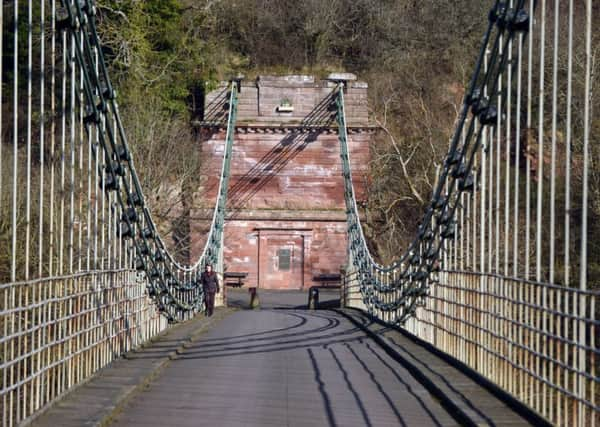Bid to save Union Chain Bridge for bicentenary


But after years spent enduring its gradual deterioration, residents on both sides of the border between Scotland are England are rallying together to help save a famous crossing.
Advertisement
Hide AdThe Union Chain Bridge was the first large scale suspension bridge in the world and is the oldest iron chain suspension bridge still in use in Europe.
Since it opened in 1820, the crossing at the River Tweed has welcomed travellers from either side into Scotland and England. Drivers with an eye for detail who slow down will even be able to read the engraved maxim on structure, which proudly states ‘Vis Unita Fortior’ or United Strength is Stronger.
However, the grand old bridge has been neglected for years, prompting Scottish Borders Council to consider closing it altogether last year.
Last year, our sister paper, Scotland on Sunday, reported how the 129 metre crossing connecting Fishwick to Horncliffe on the English bank was in such a sorry state that safety concerns meant only one vehicle at a time can now pass over it.
Now, with the bicentenary of the bridge six years away, the communities who live near the bridge are proving the maxim is true by launching a formal campaign for its full restoration in time for 2020.
Scores of people attended a meeting in Horncliffe village hall last week to mark the inaugural meeting of the Friends of the Union Chain Bridge.
Advertisement
Hide AdThe organisation said that the as well as being a “magnificent feature” in the Borders landscape and a valuable local transport link, the bridge is of “global significance in the history of engineering.”
After two hundred years of wear and corrosion the old structure urgently needs repair work to be carried out. The estimated cost of the necessary work is about £5m.
Advertisement
Hide AdThe new organisation, which has already signed up 230 members, has launched negotiations with Scottish borders Council and Northumberland County Council in an attempt to safeguard the crossing’s future.
The body is also in talks with funding bodies such as Historic Scotland, English Heritage and the Heritage Lottery Fund.
Northumberland County Council is the lead authority for the Union Chain Bridge, but it shares responsibility for its upkeep with Scottish Borders Council.
James Fell, the heritage manager for Northumberland and Martin Joyce, the capital projects officer for the Scottish Borders, attended the meeting.
During it, Fell said that the English local authority had budgeted up to £500,000 for work and that both councils had commissioned consultants to prepare a bid for lottery funding. It is understood that a formal application will be lodged in January and Fell anticipated that work to bring the bridge up to scratch will begin at the start of 2018.
The chair of the Friends of the Union Chain Bridge, Heather Thompson, has been campaigning for years to save the bridge, and said she was encouraged by the meeting.
Advertisement
Hide AdMs Thompson, who runs the Chain Bridge Honey Farm, a beekeeping firm and visitor attraction on the English side of the Tweed, said: “We are looking forward to working with the two local authorities and other agencies to get the Union Chain Bridge properly restored as a major feature of British engineering history, as a potentially valuable tourist attraction and as an iconic emblem of the Union between Scotland and England.
“We are going to do everything in our power to campaign to achieve that objective for the bicentenary year in 2020.”
Advertisement
Hide AdThe bridge was forced to temporarily close to cars in 2008 for essential repair work. Designed by Captain Samuel Brown, it is regarded as a forerunner to the Clifton and Menai suspension bridges.
The structure is considered to be of paramount importance by preservation bodies, with a A listed status from Historic Scotland and a Grade 1 classification from English Heritage. It was once in the care of the Tweed Bridges Trust, but when that organisation ceased to exist, it became the concern of the local authorities.
According to Gordon Miller, an architect and former sapper in the Royal Engineers who carried out a survey of the bridge in the 1970s, it is the “first successful road bridge in the world.”